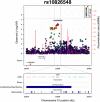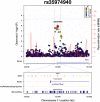Genome-wide analyses of aggressiveness in attention-deficit hyperactivity disorder
- PMID: 27021288
- PMCID: PMC5071721
- DOI: 10.1002/ajmg.b.32434
Genome-wide analyses of aggressiveness in attention-deficit hyperactivity disorder
Abstract
Aggressiveness is a behavioral trait that has the potential to be harmful to individuals and society. With an estimated heritability of about 40%, genetics is important in its development. We performed an exploratory genome-wide association (GWA) analysis of childhood aggressiveness in attention deficit hyperactivity disorder (ADHD) to gain insight into the underlying biological processes associated with this trait. Our primary sample consisted of 1,060 adult ADHD patients (aADHD). To further explore the genetic architecture of childhood aggressiveness, we performed enrichment analyses of suggestive genome-wide associations observed in aADHD among GWA signals of dimensions of oppositionality (defiant/vindictive and irritable dimensions) in childhood ADHD (cADHD). No single polymorphism reached genome-wide significance (P < 5.00E-08). The strongest signal in aADHD was observed at rs10826548, within a long noncoding RNA gene (beta = -1.66, standard error (SE) = 0.34, P = 1.07E-06), closely followed by rs35974940 in the neurotrimin gene (beta = 3.23, SE = 0.67, P = 1.26E-06). The top GWA SNPs observed in aADHD showed significant enrichment of signals from both the defiant/vindictive dimension (Fisher's P-value = 2.28E-06) and the irritable dimension in cADHD (Fisher's P-value = 0.0061). In sum, our results identify a number of biologically interesting markers possibly underlying childhood aggressiveness and provide targets for further genetic exploration of aggressiveness across psychiatric disorders. © 2016 The Authors. American Journal of Medical Genetics Part B: Neuropsychiatric Genetics Published by Wiley Periodicals, Inc.
Keywords: ADHD; GWAS; aggression.
© 2016 The Authors. American Journal of Medical Genetics Part B: Neuropsychiatric Genetics Published by Wiley Periodicals, Inc.
Figures



References
-
- Achenbach TM, McConaughy SH, Howell CT. 1987. Child/adolescent behavioral and emotional problems: Implications of cross‐informant correlations for situational specificity. Psychol Bull 101(2):213–232. - PubMed
-
- Aebi M, Plattner B, Metzke CW, Bessler C, Steinhausen HC. 2013. Parent‐ and self‐reported dimensions of oppositionality in youth: Construct validity, concurrent validity, and the prediction of criminal outcomes in adulthood. J Child Psychol Psychiatry 54(9):941–949. - PubMed
-
- Aebi M, vanDonkelaar MM, Poelmans G, Buitelaar JK, Sonuga‐Barke EJ, Stringaris A, I Consortium, Faraone SV, Franke B, Steinhausen HC, vanHulzen KJ. 2015. Gene‐set and multivariate genome‐wide association analysis of oppositional defiant behavior subtypes in attention‐deficit/hyperactivity disorder. Am J Med Genet B Neuropsychiatr Genet 9999:1–16. - PMC - PubMed
-
- Anderson CA, Bushman BJ. 2002. Human aggression. Annu Rev Psychol 53(1):27–51. - PubMed
-
- Anney RJ, Lasky‐Su J, O'Dushlaine C, Kenny E, Neale BM, Mulligan A, Franke B, Zhou K, Chen W, Christiansen H, Arias‐Vasquez A, Banaschewski T, Buitelaar J, Ebstein R, Miranda A, Mulas F, Oades RD, Roeyers H, Rothenberger A, Sergeant J, Sonuga‐Barke E, Steinhausen H, Asherson P, Faraone SV, Gill M. 2008. Conduct disorder and ADHD: Evaluation of conduct problems as a categorical and quantitative trait in the international multicentre ADHD genetics study. Am J Med Genet B Neuropsychiatr Genet 147B(8):1369–1378. - PubMed
Publication types
MeSH terms
Grants and funding
LinkOut - more resources
Full Text Sources
Other Literature Sources
Medical

